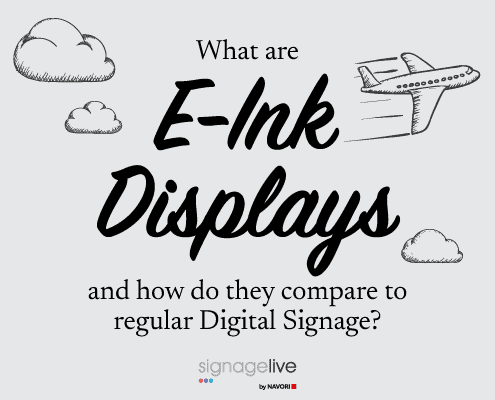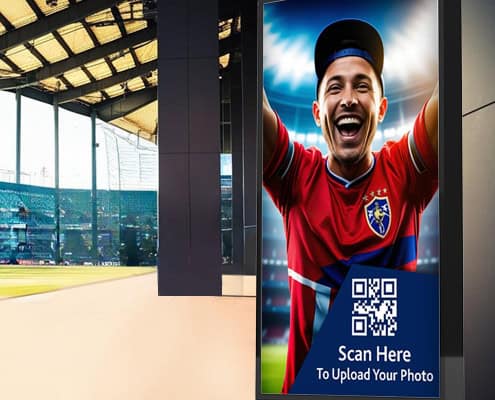Are you looking for digital signage that’s super-energy efficient and readable, even in direct sunlight? Then, e-ink displays could be the perfect solution for you.
What are E-ink Displays?
E-ink displays are designed to mimic the appearance of ink on paper. Unlike conventional digital signage, the displays are built without a backlight. This means that instead of glowing, the screens naturally reflect the light around them, just like paper does.
How Does E-ink Display Readability Compare with Standard Digital Signage?
As e-ink displays reflect ambient light, instead of emitting it, they remain clear and visible, even in harsh lighting conditions or direct sunlight.
This makes them much more versatile and flexible than standard digital signage, which requires additional technologies, including higher brightness levels and anti-glare finishes to remain readable in sunlit or artificially light environments.
Are E-ink Displays More Energy Efficient than Traditional Digital Signage?
E-ink digital displays are much more energy efficient than traditional digital signage screens, only requiring power, when the on-screen image changes. The tiny microcapsules they use are filled with black and white particles, which display – and stay on-screen once charged, requiring no further electricity to display.
What Colors Can E-ink Displays Feature?
Unlike traditional digital signage, e-ink displays are monochrome, which means they can only be used to feature imagery and/or text in:
- Black
- White
- Grey
Some modern color e-ink displays can show limited colors, like reds, yellows, blues and greens, but these will appear washed out on-screen.
What File Formats can E-ink Displays Support?
Unlike traditional digital signage, e-ink screens are only designed for the on-screen display of static imagery and text.
You can display static content in the following file formats:
- JPEG/JPG
- PNG
- BMP
- Static GIF
- TIFF
Can E-ink Displays Feature Animated Content and Videos?
E-ink digital signage can’t display video smoothly, with only a handful of e-ink tablets currently able to do so for limited, grayscale, low resolution and frame rate clips.
Similarly, animations won’t display on-screen.
What are the Advantages of E-ink Displays over Traditional Digital Signage?
E-ink displays are:
- Readable in brightly lit environments
- Backlight-free and therefore low maintenance and long-lasting
- Ultra-energy efficient
- Cost-efficient to run, requiring minimal energy
- Glare-free and so easy on the eyes
- Thin and lightweight for minimalist installations
- Quiet during operation
How Much Do E-ink Displays Typically Cost?
Compared to traditional digital signage, e-ink displays are generally more costly.
Small-medium 25”-32” displays typically retail from around $1,608 to $2,010 USD.
What Screen Sizes are Available for E-ink Displays?
E-ink displays come in a variety of sizes, including:
- Small – 13” – 17” screen sizes
- Medium – 25” – 32” screen sizes
- Large – 42” – 76” screen sizes
Are E-ink Displays Compatible with Digital Signage Software?
The good news is that e-ink digital signage displays are compatible with most cloud-based content management systems (CMS), like Signagelive, which means you can remotely edit, manage and schedule content.
With a cloud-based, CMS, you’re able to:
- Schedule the end and start date/times of your content, so that it never over-runs beyond its allocated time slot
- Automate bulk message delivery to pre-categorised screens, based on, for example, their location
You just have to be aware that, given the e-ink display technology, only static content can be scheduled. The e-ink displays’ slow refresh times also mean that content will be slower to update than for traditional digital signage.
Can E-ink Displays be Used for Outdoor Signage?
Purpose-built e-ink displays can be used for outdoor signage, coming with weather-sealed and IP-rated panels.
While they do tend to be more costly than traditional outdoor signage, and are only designed for slow-changing static content, they are extremely energy efficient and offer excellent sunlight readability.
Where Do E-ink Displays Work Well as Digital Signage?
E-ink digital signage works well in any scenario that doesn’t require quick on-screen updates, or animated content.
Retail and Supermarkets
E-ink displays can be used as:
- Electronic shelf labels
- Product specification displays
- Small point-of-sale signage
Transport
E-ink signage is being increasingly installed outdoors at bus stops or in train stations and airports.
The screens are perfect for the display of:
- Static timetables
- Route information and delays
- Wayfinding information
Office and Corporate Buildings
E-ink signage is ideal for displaying:
- Meeting room schedules
- Directories and visitor information boards
Education and Libraries
E-ink digital signage can also be used to feature:
- Class schedules and room booking
- Event notices and library information boards
Museum and Galleries
E-ink displays are great for displaying:
- Exhibit descriptions, labels or artifact information
- QR codes or educational static content
Outdoor/Low-power Installations
Finally, e-ink displays work well as:
- Solar-powered information boards
- Park, trail or community signage
In the right business scenario, e-ink displays can enhance the visibility and impact of your signage, as well as save energy and advance your sustainability goals. Compatible with cloud-based content management systems, they offer a user-friendly and low maintenance solution for multi-screen networks. Ready to build out a solution for your e-ink signage? Reach out today.





You must be logged in to post a comment.